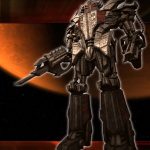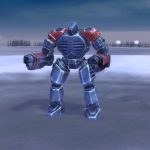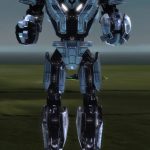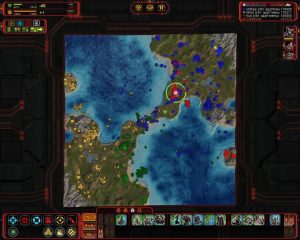
Supreme Commander: Forged Alliance is a top-down real-time strategy game and a standalone expansion to the original Supreme Commander. It was released in November 2007 on PC and was developed and made by the company Gas Powered Games and published by THQ. It is the second game in its franchise and is widely proclaimed as the best of the three games released.
Gameplay and replayability
Supreme Commander: Forged Alliance is a faithful rendition of the original game, following the same top down real-time strategy and tactical management as the original. The main gameplay loop is simple, using the starting unit as the player character, you construct an army with which to fight and defeat your opponent. This can be done in any number of ways as you have access to all traditional aspects of war; land, air, navel, information and logistics. You need a combination of all aspects to achieve victory, as using only one or two of these things will leave you at a disadvantage. In Supreme Commander: Forged Alliance there are 4 distinct races, up from the 3 of the previous game. They each have distinct aesthetic and play style.

- The UEF (United Earth Federation), – a conventional ballistics-using force, using defensive and direct fire as their strengths with a blocky and solid aesthetic.
- The Cybran Nation – a faction focused on information retrieval and denial, whose main mode of offence are lasers and missiles and have an angular and sharp aesthetic.
- The Aeon Illuminate – a faction whose tech is basically described as space magic, who use only direct energy weapons which are high damage low rate of fire. Their general aesthetic is more circular and flowing.
- Lastly are the Seraphim – a faction that doesn’t have a niche as such, instead being decent or above average at everything but at the same
 time
time  being less varied and thus easy to counter. Their aesthetic is alien and floaty, for lack of a better word.
being less varied and thus easy to counter. Their aesthetic is alien and floaty, for lack of a better word.
The game has a fairly fleshed out campaign, with about 8 missions each one playable as one of the original three factions on 3 different difficulties. This, in total is easily 50+ hours alone without replaying the same mission as the same faction. The story itself is well thought-out and made with continuity in mind. It makes sense but is not truly that deep and is just there to add flavour. Most characters are two-dimensional and as you are the silent protagonist all things are scripted. The other way to play the game is in skirmish mode. This mode can be played in any number of ways. With human players or bots, with one-player maps that are tiny in size or massive 10 player maps that can take upwards of four hours to finish. They are incredibly varied in the scope of what you can do. And, as such, can play a new combination every skirmish every time and have it always be different. The actual game itself is very well optimised for what it is, a complete simulation of a mock war. A proof of this from my own experience, is that you can actually crash an aircraft into your enemy’s nuclear missile as it’s launching and get it to prematurely detonate on top of their base. I can attest to this being a truly satisfying felling.
Control

As this is a real time strategy game with an extensive roster of structures and units, it is going to have a lot of key binds. For a new player, especially one who doesn’t play other RTS like it, this could be quite daunting and may prefer to stick to using just the mouse. As you can actually do everything you to do with the mouse you this makes the controls easy to use and hard to master. The interface is well designed simple symbols with short descriptions for ease of access in the case of the actually controlling your units. The build interface, being such an important part of the game and what makes up the majority of the interface, is designed very well. With a combination of pictures of the exact thing you are building as well as simple description and summary of what that particular unit or structure does makes for an intuitive and easy to understand menu.
Graphics and sound
For a game released before 2010 it has very good graphics for how well it runs. This is partially because of the sheer scale of the maps you play on and the amount you can zoom in and out; close enough to see the waves and far enough out that the battle ships that you make are barely visible. The game fixes render distance issues by replacing everything with symbols after a certain distance. All models are 3-D and very well detailed, with animations appropriate with what the buildings or units are doing. Cruiser launching a missile, appropriate tiny hatch opens, experimental walker steps on an enemy tank, tank is crushed and explodes leaving nought but wreckage. While this happens you can be panning around in a free cam then instantly switch back to the overhead view only to pause so as to observe an enemy shell heading for your innocent tech 1 scout, that was only out in the field to find a weakness in an enemy position (all actually done by me by the way). The sound design is probably the weakest point of the whole game. Listening to the looped sounds of marching assault bots incorrectly layered can get very tiring very quickly. As it is adjustable in the menu, it is easily turned down to lower levels. The music of the game is not going to win any awards but is appropriately epic for the scale of the game and something to drown out the not quite up to par sound effects.
A final thought
Overall, Supreme Commander: Forged Alliance is a very good game. With hours of fun to be had plating it. It fills a nice little niche and because of that has attracted a very loyal fan base that has keep playing and supporting it long after it has stop being developed. Supreme Commander: Forged Alliance is a game that anyone could enjoy, with veterans of the strategy genre in particular able to find the most joy. One of my personal favourite games and, as such I give Supreme Commander: Forged Alliance a 9.5/10.